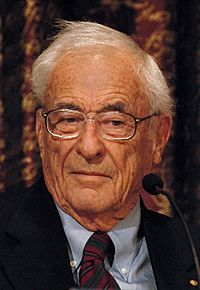Willard Boyle facts for kids
Quick facts for kids
Willard S. Boyle
|
|
|---|---|
 |
|
| Born | August 19, 1924 |
| Died | May 7, 2011 (aged 86) Wallace, Nova Scotia
|
| Citizenship | Canada |
| Alma mater | McGill University Lower Canada College |
| Known for | Charge-coupled device |
| Awards | IEEE Morris N. Liebmann Memorial Award Draper Prize Nobel Prize in Physics (2009) |
| Scientific career | |
| Fields | Applied physics |
| Institutions | Bell Labs |
Willard Sterling Boyle (born August 19, 1924 – died May 7, 2011) was a Canadian physicist. He is famous for co-inventing the charge-coupled device (CCD). This invention changed how we capture images.
On October 6, 2009, he won the Nobel Prize in Physics. He shared the award for inventing the CCD sensor. This sensor is a special electronic circuit that captures images.
Contents
Early Life and Education
Willard Boyle was born in Amherst, Nova Scotia, Canada. His father was a medical doctor. When Willard was three, his family moved to Quebec. His mother, Beatrice, taught him at home until he was fourteen.
He then went to Montreal's Lower Canada College. After that, he studied at McGill University. His studies were paused in 1943. He joined the Royal Canadian Navy during World War II.
He was sent to Britain's Royal Navy. There, he learned how to land Spitfire planes on aircraft carriers. The war ended before he finished his training. He later earned three degrees from McGill University. He received his Bachelor of Science in 1947. He got his Master of Science in 1948. Finally, he earned his PhD (Doctor of Philosophy) in 1950.
Career and Major Inventions
After finishing his studies, Boyle worked at Canada's Radiation Laboratory. He also taught physics for two years. In 1953, he joined Bell Labs. This was a famous research company.
Developing Lasers and Space Science
At Bell Labs, Boyle made important discoveries. In 1962, he and Don Nelson invented the first working ruby laser. A laser is a device that produces a strong beam of light. He also helped create a semiconductor injection laser.
In 1962, he became a director at Bell Labs. He led the Space Science and Exploratory Studies team. His team helped the Apollo space program. They even helped choose landing spots on the Moon. In 1964, he returned to working on integrated circuits. These are tiny electronic circuits.
Inventing the CCD Sensor
In 1969, Boyle and George E. Smith invented the charge-coupled device (CCD). This was a huge step in photography. Before CCDs, cameras used chemicals to take pictures. CCDs made electronic photography possible.
The CCD sensor captures light and turns it into electronic signals. These signals then form a digital image. This invention changed cameras forever.
Impact of the CCD
The CCD had a massive impact. NASA used CCDs to send clear pictures from space back to Earth. Today, CCDs are in many digital cameras. They are also in smartphones and video cameras.
George E. Smith once said about their invention: "After making the first couple of imaging devices, we knew for certain that chemistry photography was dead." This shows how revolutionary the CCD was.
Awards and Later Life
Willard Boyle received many awards for his work. He and George E. Smith won several honors together. These included the Stuart Ballantine Medal in 1973. They also received the IEEE Morris N. Liebmann Memorial Award in 1974. In 2006, they won the Charles Stark Draper Prize.
The biggest award came in 2009. Boyle and Smith shared the Nobel Prize in Physics. This was for their invention of the CCD.
Boyle was an Executive Director of Research at Bell Labs. He retired in 1979. After retiring, he spent his time in Nova Scotia. He lived in Halifax and Wallace, Nova Scotia. With his wife, Betty, he helped open an art gallery. Betty was a landscape artist.
Willard Boyle married Betty in 1947. They had four children, ten grandchildren, and one great-grandchild. In 2010, he was made a Companion of the Order of Canada. This is a very high honor in Canada. Willard Boyle passed away in Wallace in 2011 from kidney disease.
See also
 In Spanish: Willard Boyle para niños
In Spanish: Willard Boyle para niños

